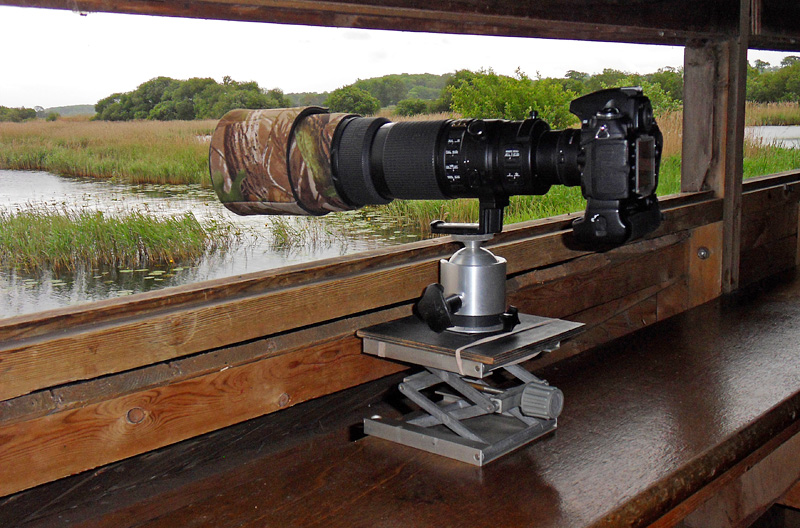
| Blashford Lakes Hide Guide
This hide guide is basically from a photography point of view for photographers, and is just my own view based on the many hours that I've spent in the hides, though I hope it is useful to other photographers, especially those yet to visit the reserve. There are five main hides all built to very high specification by Gilleard Brothers in recent years, so good modern hides with standardised window sizes/shelf heights/bench heights, and with opening windows all fully glazed. I've listed them below in north-south order (as per map), and there are also a number of screens here and there. Most of the perimeters of Ibsley Water and Ivy Lake have dense trees/bushes/vegetation with no access permitted, so the hides (and screens) are pretty much the only 'proper' viewing points for these lakes from within the reserve. Access to all of these main hides is via good, clear, gravelled paths which are all over level ground (apart from a small section through some woods which can be avoided by alternate level routes) so good for wheelchair-photographers and ideal for those who prefer to tote their large heavy lenses in wheeled buggies. |
Section of Blashford Lakes Wildlife Reserve map main area showing hide positions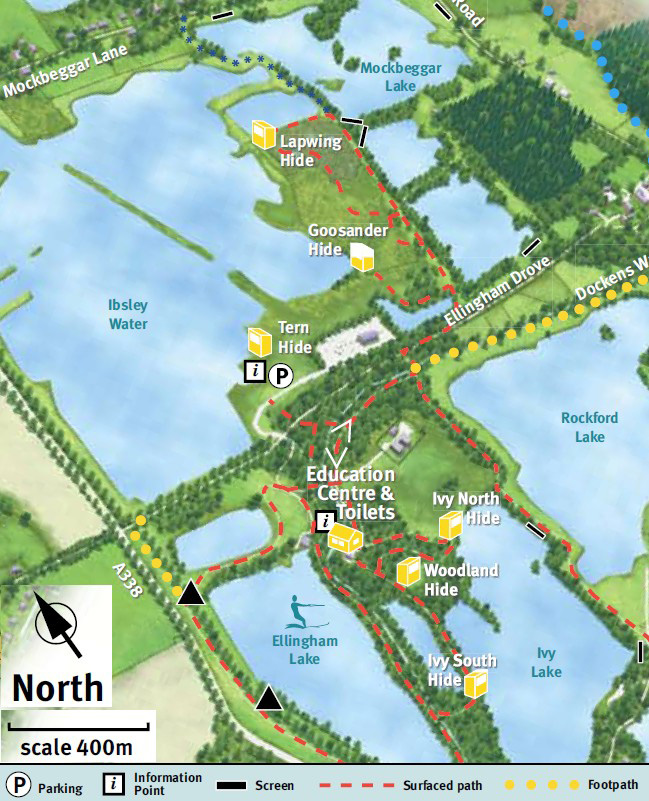 Map section reproduced with kind permission of Hampshire & Isle of Wight Wildlife Trust Blashford Lakes are just north of Ringwood, in west Hampshire. |
|
Lapwing Hide |
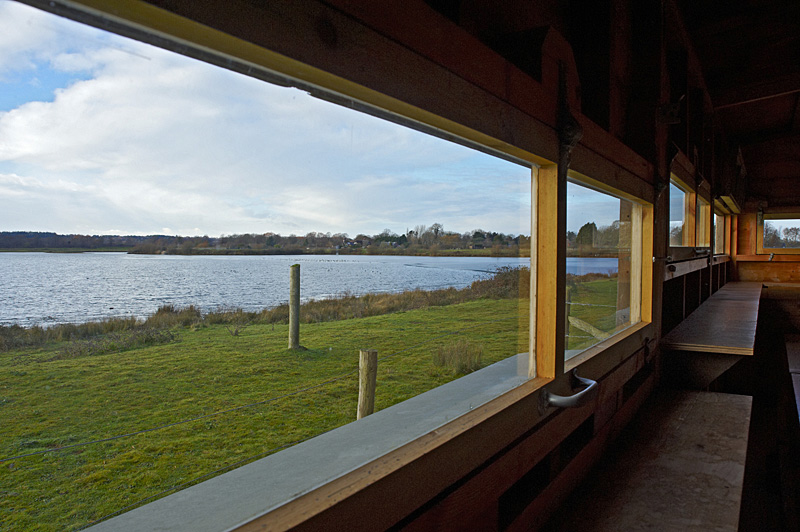
|
|
Situated in the north part of the reserve and is the most northerly hide in the main area of the reserve. It faces west and overlooks a grassy and vegetated low bank to the foreground and the northern part of Ibsley Water, and gives extensive views of most of Ibsley Water, including right down south to the Tern Hide (see below). It is a 'standard' sized hide with four front opening windows (one low with wheelchair access) and single opening window at each end - one looks out onto low bramble bushes with willow/reedbed behind, barbed wire fence and grassy area, the other looks out onto grassy area and close willow tree.
This is a good observation hide for those with telescopes but less good for photography, and, although I cannot say I've spent a lot of time in this hide, I have made frequent visits to it but have not managed to get any shots (of anything) that are worth putting in the showcase - so far. [update Aug 2012 - some images of Little Egret!] Apart from shooting against the light in the afternoons, the main 'photographic issue' with this hide is that it is quite set back from the edge of the lake, by some 30 metres or so, with grassy area in front and rough sedge grassland nearer the water (as in photo), which means birds on the water or the (mostly vegetation-obscured) shoreline are a long way away for photography. I'm not sure why it's called 'Lapwing hide', maybe when it was first built Lapwings were regular there but in all the visits to it I've made I can't say I've ever seen a Lapwing other than quite distant fly-pasts(!). I've never seen any birds of note close enough to photograph on the grass bank between the hide and the water, nor on the one or two wooden posts near the hide, and the extensive sedge grasses along the edge of the lake obscure from view any birds that may be along the water's edge. There is usually an exposed small peninsula of muddy shingle directly out from the shore in front of the hide on which some birds can be more easily seen, such as Goosander which sometimes sit and preen or snooze providing good views, though too far for good photography (possibly ok for digiscoping or those with very long lens/converter combos). There are a few wooden posts there also, on which some birds may perch (Osprey maybe?!) but still a relatively long way away. In early 2013 a dead tree with platform was erected about 200m north of the hide in the hope of Ospreys using it. Sometimes, small birds such as warblers can be photographed from the end windows where the trees and vegetation are quite close. I have, on occasion, had good views of Fox near to the Lapwing Hide, as they work their way around the lake, and Fallow and Roe Deer may show themselves occasionally when they come out of the reedbeds to the south to feed on sedges, etc.. The hide itself may not be very good for photography but it's always worth a walk up to it and back around the loop path as there is always the chance of other close opportunities with Fox, Rabbit, deer, (Roe, Fallow, and I have had my closest view of a Muntjac there) and birds such as woodpeckers. One of the great things about Lapwing Hide is that it has a timer door locking system which prevents entry but permits exit, and operates at preset times. This means that it's possible to remain in the hide after the 'official' 4.30pm closing time and stay later in the evenings without fear of being 'chucked out', as with most of the other hides in the main part of the reserve, which are locked up and unlocked by the wardens. It also means it's possible to get into the hide earlier than the official 9.00am opening time too (though I'm not sure how early the timer lock is set), and early mornings are probably the best time of day to try your luck in this hide. Photographs from Lapwing Hide in showcase - Little Egret. |
|
Goosander Hide
|
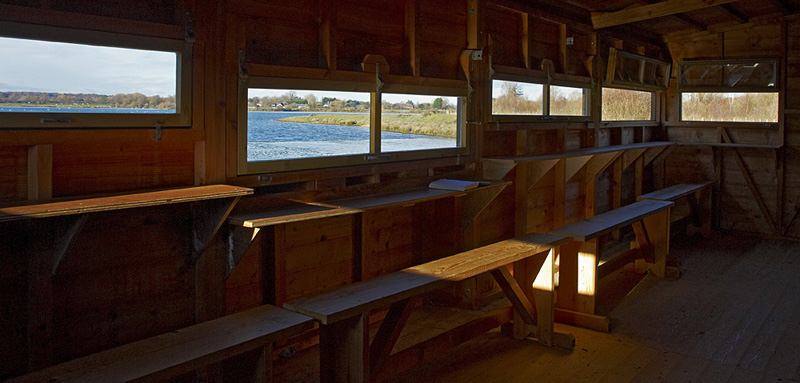
|
|
Situated in north part of the reserve, faces west and overlooks a bay area of Ibsley Water. 'Standard' sized hide with four front opening windows (one low with wheelchair access), and single opening window each end - one looks out onto nearby twiggy bushes, the other views onto more open grassy (track) area with bushes and trees backround.
Called 'Goosander Hide' because large numbers of Goosander usually gather in the bay during winter evenings (usually in fading light and not very close for photography), though its main 'claim to fame' and Blashford's jewel in the crown must really be the Sand Martin colony in the man-made nesting bank right in front of and below the hide. In the spring and summer months it is a wonderful sight to see the Sand Martins whizzing in and out right in front of the hide (and occasionally right into the hide!) and sometimes at rest on nearby twiggy branches and placed perches. Originally, it wasn't possible to actually see many of the nesting-holes but this was rectified In early 2010 when the bank was extended to the south by nearly 10 metres, following the curve of the land, and now provides a good view of some of the vertical wall and many holes (see photo below) - in the midsummer months (May/June/July) this part of the wall briefly gets some direct sunlight early in the morning, as the sun rises more to the north-east behind the hide, before falling into shadow from the bank itself as the sun moves south, and is also lit by the sun in later afternoons/early evenings as it drops to the north-west and sets. |
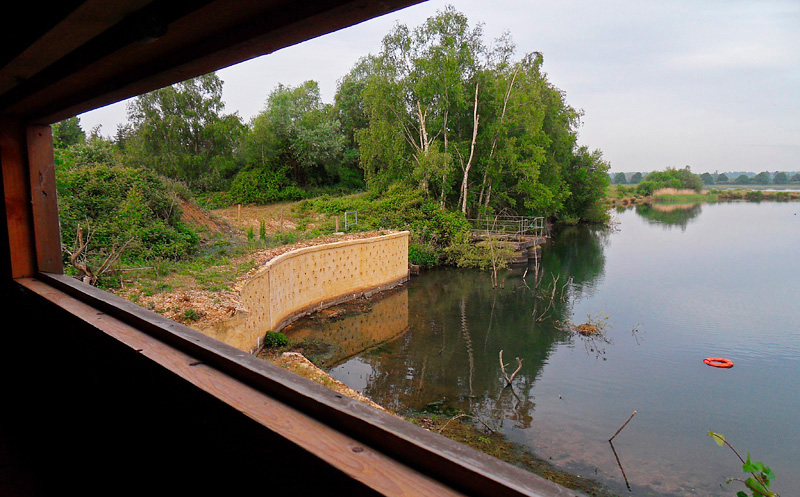
|
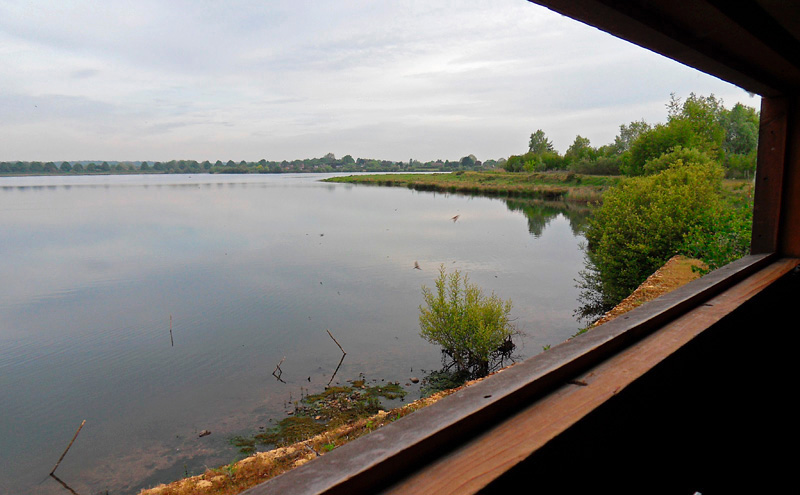
|
|
From a photography point of view, apart from the difficulties of shooting into the light in afternoons, the main problem is that the hide is pretty high overlooking the lake (the windows are some 5 metres above the water level) which gives a rather steep angle down to birds on the water when they are closer in to the hide. This effect is lessened the further out they are and a longer lens is used which helps to flatten out the angle. Many subjects on the water can be just too far away but frequently birds come in closer, sometimes right in front of the hide - most likely are birds such as Little Grebe, Great Crested Grebe, Coot, Cormorant, Mallard and Sand Martin of course, and sometimes Grey Heron and Little Egret. Great Egret has sometimes shown well here but not usually closer than 80 metres or more. Kingfisher also occasionally puts in an appearance, and there are usually some obvious perch-sticks put in the water in front of the hide, as well as more natural-looking trees and twigs. Sometimes passage waders such as Common and Green Sandpiper, visit the shore in front of the hide and very occasionally Snipe may be there first thing when water levels are low enough to expose some foreshore.
The Sand Martin colony often attracts prey birds in, especially when the young martins are just fledging, and Hobby, Sparrowhawk and Peregrine sometimes come in close. Smaller birds such as Wren, Robin, Tits and various Warblers may be photographed in the bushes close to the end windows, and woodpeckers may land in the Birch trees to the south, though not really close enough for good photography. Foxes and deer (Roe and Fallow) can be seen occasionally, from the hide and on the walk to the hide. Despite its high position, this is one of the better hides for photography as can be seen by the variety of showcase images, though long lenses are needed. In winter months the water is usually right up to the base of the nesting-bank but there is usually some shoreline visible when the water levels drop in summer. The water in front of the hide may be nicely calm even on breezy days if the wind direction is mainly from an easterly direction, as the bank, trees and hide provide some shelter from the wind. Click here for a short video (links to YouTube) I shot which shows the view from the hide (with Sand Martins). As with Lapwing Hide, Goosander Hide has a timer locking system, allowing one to enter the hide early (0615 is the earliest I've gone into the hide) or stay in it later, perhaps to enjoy a setting sun. Update October 2011: a double set of perching rails was put up in the water in front of the hide about 50m out. I can't say I like them - they're not photogenic even with birds on them and will likely just be a nuisance for photography of birds in the bay. Photographs from Goosander Hide in showcase - Fallow Deer, Roe Deer, Black-headed Gull, Blue Tit, Common Sandpiper, Coot, Cormorant, Garden Warbler, Goldfinch, Great Crested Grebe, Green Sandpiper, Green Woodpecker, Grey Heron, Grey Wagtail, Hobby, Kingfisher, Little Egret, Little Grebe, Mallard, Moorhen, Mute Swan, Peregrine Falcon, Sand Martin, Sparrowhawk, Grass Snake. |
|
Tern Hide
|
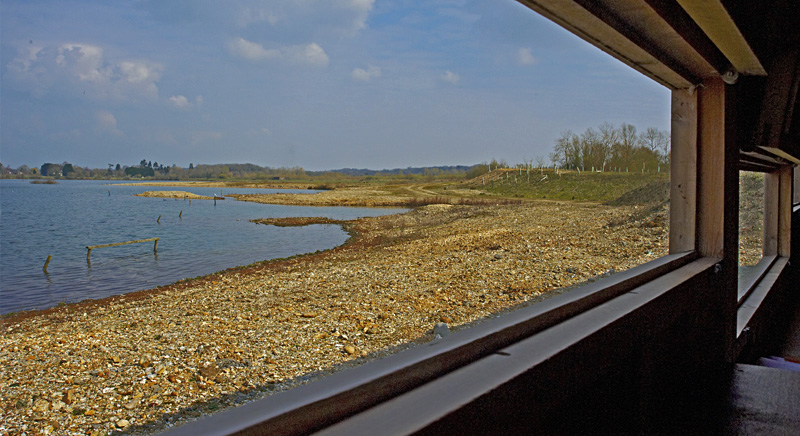
|
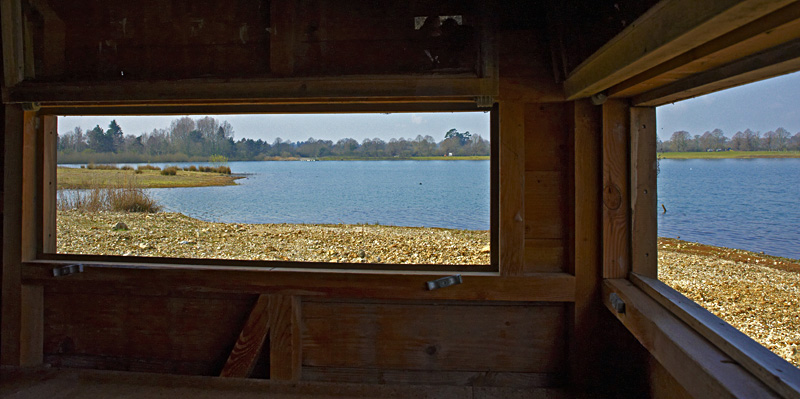
|
|
Situated in north part of reserve and is one of the main hides (so is unlocked and locked by the wardens), with ample parking right beside it. Faces north, overlooking Ibsley Water and shingle shore. Larger hide with six front opening windows (one low with wheelchair access) and single opening window at each end - one overlooks shingle shore and south-west part of Ibsley Water, the other overlooks shingle shore and vegetated shingle bank. The front windows look directly onto a large slightly vegetated shingle bank in front of the hide, with the lake edge just 10 metres or so beyond. The hide windows are just 1.5 metres above the shingle (so possible to get low-angle-looking shots of birds on the shingle) and about 2.5 metres above the surface of the lake. Called 'Tern Hide' because a small colony of Common Terns originally nested on the shingle spit and island about 50 metres away, though they now all relocate to the purpose-built nesting rafts provided for them each summer on Ivy Lake where they have had great breeding success, a credit to the reserve management. This is probably the best viewing hide at the reserve - if you have a telescope that is! It overlooks most of Ibsley Water which holds a great number and variety of birds throughout the year, albeit most of them a long way off, though some birds may be seen on the shingle in front of the hide and also nearer on the water. The Tern Hide's main 'claim to fame' has to be the Little Ringed Plovers, a pair of which usually nest on the shingle each year right in front of the hide - the closest was, I think, about 4 metres away!, so wonderful close views of this delightful little wader and with their chicks later, a great opportunity to photograph a Schedule I protected species at the nest without requiring a license to do so! It's thought that they derive some protection from egg/chick predation by Crows which do not like to come too close to the hide, though, sadly, few of their offspring seem to last more than a week once they move farther away from the hide, presumably down to predation. Other birds regularly on the shingle in front of the hide include Lapwing (often with chicks) and Pied Wagtails with their offspring in the summer months when invertebrate food there is plentiful, and along the water's edge can sometimes be seen Redshank (mainly spring months), sometimes Common Sandpiper, Green sandpiper, Dunlin, and occasionally Snipe and Greenshank - even a Whimbrel has been photographed on the shingle shore. On the water, Great Crested Grebe and Little Grebe frequently swim in close (but are still quite distant for photography) along with occasional Coot, Mallard, Tufted Duck, Gadwall, Teal, Shelduck, Canada Goose, Greylag Goose, Cormorant, and occasionally Goldeneye (mainly winter months). Now and then some of these geese or ducks come onto the shore close by the hide. In the water just offshore in front of the hide are a few wooden posts and a floating tethered wooden pontoon, the posts sometimes perched upon by Common Tern as well as Black-headed Gull, the pontoon usually by various ducks or Coots. The open aspect and wide vista afforded by the Tern Hide make it a favourite for birders, especially with a telescope (the very short walk from the car park probably helps too!), and some 'goodies' can be seen on and over the lake, from Black Tern to Osprey to Great Egret. For photographers the choice is a bit more limited depending on the time of year and luck on the day, but apart from the 'usual suspects' closer in (Little Ringed Plover, Lapwing, Redshank), there is always the chance of something dropping by on the shingle or flying past such as Peregrine Falcon. It's still one of the better hides for photography, as can be seen by the variety of showcase images, but can be one of the busiest hides people-wise. Wind direction can be an important factor at the Tern Hide - any kind of northerly wind can be quite cold as it comes over the water and into the hide windows!, especially in winter and spring, whilst at the same time one can sun-bathe outside the south-facing door! The water may be breaking in waves on the shoreline, pushing birds away to feed in more sheltered areas. Additionally, birds will likely then be flying away from the front of the hide, into wind. Mainly southerly/easterly winds mean the birds will likely be flying more in towards the hide and also that the water in front of the hide may be more sheltered and calm. It's worth bearing in mind also that, during the summer months (May-August), by 0900 (official hide-opening time) the sun is already high in the sky and, although the lighting may be ok for some shots, on clear calm days the heat shimmer off of the shingle in front of the hide can be a problem and may degrade the quality of shots of birds on the water or more than a few metres away on the shingle. Cloudy summer days often provide better lighting for shooting from the Tern Hide during the summer months. Photographs from Tern Hide in showcase - Black-headed Gull, Buzzard, Canada Goose, Common Sandpiper, Common Tern, Coot, Egyptian Goose, Gadwall, Goldeneye, Great Crested Grebe, Grey Heron, Greylag Goose, Jackdaw, Lapwing, Little Egret, Little Grebe, Little Ringed Plover, Mallard, Mute Swan, Peregrine Falcon, Pied Wagtail, Redshank, Shelduck, Tufted Duck. |
|
Ivy North Hide
|
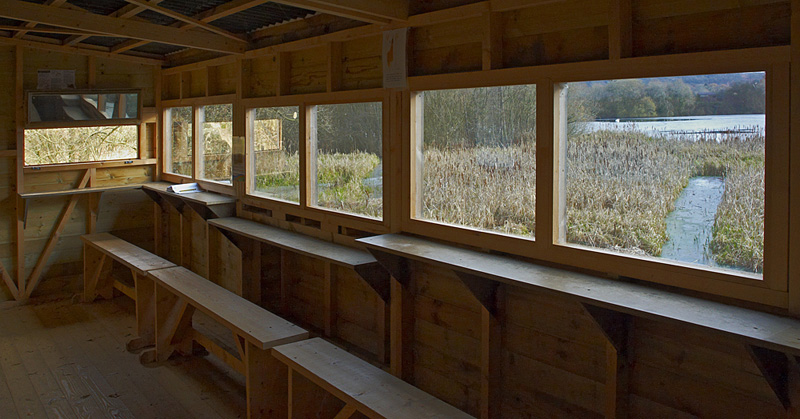
|
|
Situated in main part of the reserve (so is unlocked and locked by the wardens), faces east and overlooks north part of Ivy Lake. Front windows several large non-opening with one-way glass (one low with wheelchair access), and single opening window at each end of the hide - one overlooks trees and the reedbed, the other looks into a wooded marshy area. The non-opening front windows with one-way glass makes this hide problematic to shoot from - I've not tried shooting through the glass (yet) so I don't know what the quality is like but I know there is a two stop light loss [update Feb 2011 - some shots through glass, click on thumbnail images below]. During non-winter months the morning light can be a problem as the sun shines directly into the windows of the hide. The hide situation is quite high, with the windows some 3 to 4 metres above the water which in front of the hide is covered by an area of Reeds and Reedmace ('Bullrush'), which can look very fine most of the year, both when the Reedmace has its dark brown seedheads and when they actually break open to release the very fluffy seeds (see seasonal photos below).
The main attraction of this hide is usually Bittern in the winter months, which in 2008/2009 (before I knew of the reserve) apparently gave great views, sometimes right in front of the hide. On my visits in winter 2009/2010 one was in residence but was not nearly as accommodating and seldom appeared for me......though I have to admit to having not put in that much time trying to photograph from this hide. Cetti's Warbler is often seen close in front of the hide, and has given me my best views of this usually easy-to-hear-but-difficult-to-see bird, and also Water Rail may often be seen (mainly winter months), in both the wooded swampy area to the south as well as right in front of the hide, and again I've had my best views of this species here. I have also seen Woodcock in the swampy woodland area. During the summer months there is generally less to see close in and the growth of new vegetation makes it more difficult to see what is there anyway (see the photos below) and the increase in plant density likely puts off herons from coming in. Roe Deer may be seen close in by the hide early in the day as they browse on this new vegetation. Mute Swan sometimes nests amongst the reeds in front of the hide and may be easily seen, also Coot. I think the fact that my showcase has no images at all taken from Ivy North Hide [update Jan 2011 - now images of Bittern!] [update Feb 2011 - now images of Great Egret! and Water Rail] rather sums up either how poor it is for photography or how poor my luck has been there..... (more the latter methinks) - others have done better, with good views of Great Egret (with Little Egret) at the edge of the reebed, and apparently even an Osprey sat on an old dead birch tree in the water about 40 metres out. Maybe I should put more time in there - but there is still the problem of those non-opening one-way front windows.... [update Feb 2012 - more time in hide and more images of Bittern] This hide can get busy and quite crowded during some winter days when Bittern is in residence and reported showing, both with people just wanting to see a Bittern but especially with photographers wanting to photograph one! and the end windows can get a little cramped (and, apparently, tempers a little frayed!....). Photographs from Ivy North Hide in showcase - Bittern, Canada Goose, Cetti's Warbler, Coot, Great Egret, Great Tit, Grey Heron, Kingfisher, Moorhen, Water Rail, Wren. |
| Through the glass darkly.....at Ivy North Hide (click on thumbnail for more info): |

|

|
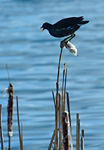
|
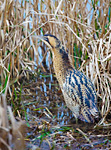
|
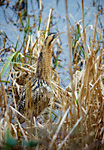
|
What a difference a month makes! - almost exactly one month between these two images:
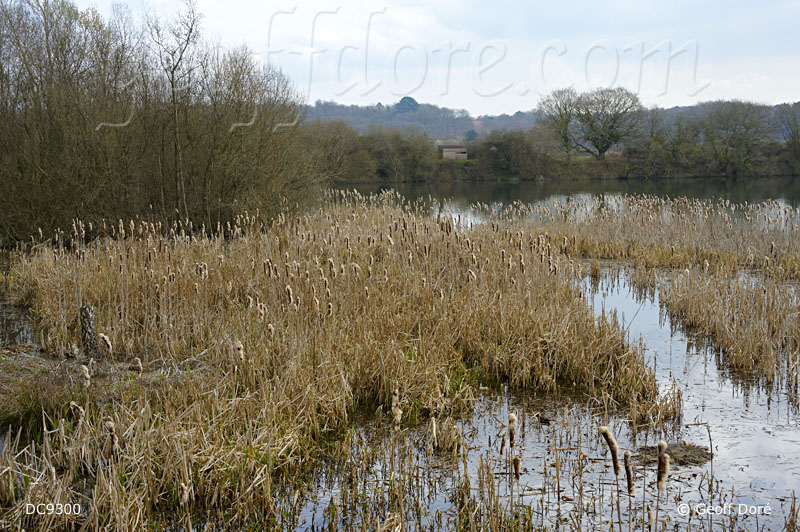
|
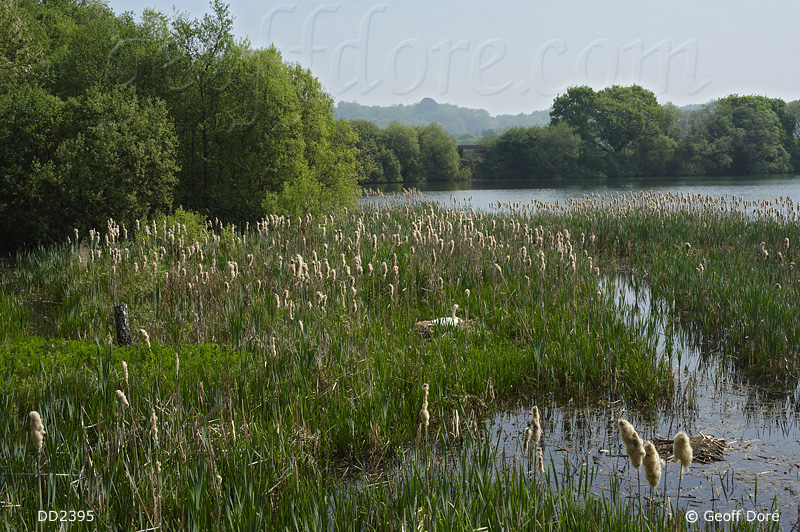
|
|
Woodland Hide
|
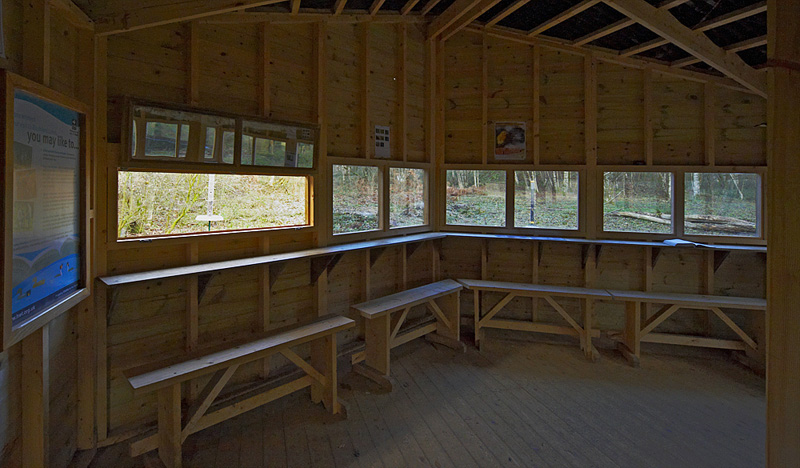
|
|
Situated in the centre of the main reserve (so is unlocked and locked by the wardens), within the woodland, hence its name. Looks out on to oak woodland area, part open glade, part shady, with a number of bird feeders close to the hide. This is the most unusual of all the hides as it is hexagonal (six-sided) in shape with many large windows, providing almost all-round viewing.
Unfortunately, from the point of view of photography, only two of the windows open, the rest are all large non-opening windows with one-way glass which, though good for viewing birds on the numerous close feeders, means a loss of two stops of light in woodland conditions where light is already at somewhat of a premium (can be seen in the photo how much dimmer the large windows look). The very first time I went into this hide, in spring 2009, I met two photographers in there trying to photograph a Great Spotted Woodpecker - on a feeder, in the shade, through the glass! and lovely through the Great Spotted Woodpecker is it seemed a pretty desperate way to get shots of one! They do sometimes land on the nearby trees, within a reasonable range, but almost always in front of the one-way glass windows. Lovely close views on the feeders though. The two windows that open are either side of the door and both give views to feeders (and perches of various kinds) and nearby twiggy trees, though one window is much better than the other and tends to get crowded with photographers (at one window, three is definitely a crowd!). Birdwise, the 'usual suspects' can be found here visiting the feeders - Great, Blue, Coal and Long-tailed Tits, finches such as Goldfinch, Chaffinch, Greenfinch, Siskin, Redpoll, and Linnet, and others such as Great Spotted Woodpecker, Nuthatch, Collared Dove, or on the ground below the feeders birds such as Robin, Dunnock, Blackbird, but there are also some less usual birds such as Brambling (winter months) and sometimes Reed Bunting. I'm not much 'into' photographing small birds, and definitely not when they are on feeders! and usually not on the obvious set-up perches either (everyone ends up getting the same shot basically) but it is possible to get different, more interesting and natural-looking shots when the birds land on nearby tree branches and twigs. Photography aside, it is just nice to be so close to these smaller birds and to spend a little time watching their activities on and around the feeders. Occasionally, all this concentration of birds brings in a Sparrowhawk - but blink and you might miss it!. Non-bird visitors around the hide include Grey Squirrel, Short-tailed Field Vole, Wood Mouse and Brown Rat (and at night, Badgers - sometimes there are organised Badger-watching evenings at the hide). So, usually plenty of subjects at which to point the camera (and usually plenty of cameras pointing.....). I often hear photographers griping about the one-way glass and shortage of opening windows, especially in the Woodland Hide, but they should remember that the primary purpose of this hide in particular is for the education of children mainly, where their excitable movement is hidden from the birds who, in the absence of associated movement, will happily habituate to some extent to noisiness from the hide. The hide does provide a 'convenient' platfrom from which to photograph some of the smaller woodland birds and, although I'm not really into photographing small birds, I have taken a few shots there myself a couple of times, but anyone who is seriously interested in such photography should set up their own feeding stations and their own hide and they can then 'design' their photographs with suitable perches and backgrounds. There are other hanging feeders in the reserve here and there and it's quite possible to set up a perch next to them and sit quietly near by and the birds will come in. Photographs from Woodland Hide in showcase - Brambling, Long-tailed Tit, Nuthatch, Redpoll, Siskin. |
|
Ivy South Hide
|
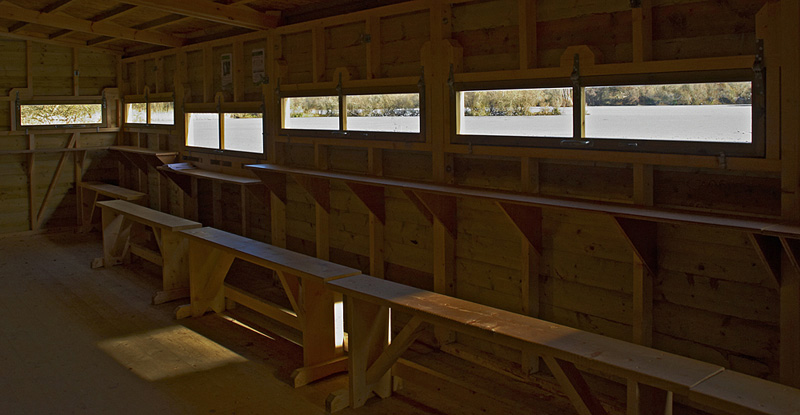
|
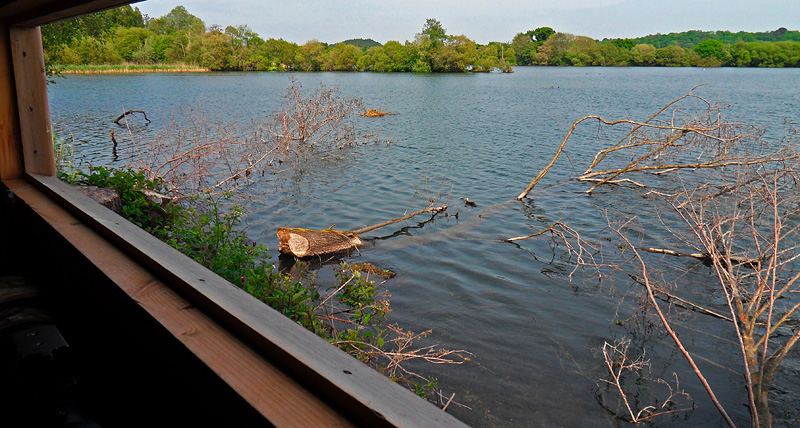
|
|
Situated in main part of the reserve (so is unlocked and locked by the wardens), faces east and overlooks Ivy Lake. Early in 2010 the original smaller unglazed hide was replaced with a much bigger and better fully glazed hide (by Gilleard Brothers) which is a slightly larger than standard hide with five front opening windows (one low for wheelchair access) and single opening window at each end - one looks out onto a small twiggy bank and small patch of reeds with close woodland edge, the other looks out onto a side water channel and trees. Not such a high position hide, with windows just 2 metres or so above the surface of the lake so better angle for photography of birds on the water closer in. Some Alder trees that were in front near the original hide were felled and left in the water to provide cover for water birds and perches for Kingfishers - very useful if / when Kingfishers land (infrequently, though this is still the most likely hide to see and photograph perched Kingfisher) but the branches can be an obstruction to views of birds on the water. As with Ivy North Hide, for most of the year mornings can be problematic as one is shooting into the light.
The hide looks directly to the floating wooden nesting rafts (4 usually) for Common Terns which are moored each summer in the middle of the lake some way away (over 100 metres) and on which the 20 or so pairs of Common Terns have had great breeding success. In my experience the terns do not come near to the hide, apart from occasionally flying past or over. Grebes often swim in close to the hide and Great Crested Grebes sometimes nest on man-made floating vegetated islets regularly put out, some 20 to 30 metres away from the hide. Grebes, Coots and ducks are the usual bird fare here, sometimes with very close views of Great Crested Grebe and Little Grebe - including, if you're lucky, swimming underwater ! (click here for a short video (links to YouTube) I shot of Great Crested Grebe swimming under the water surface).- as well as Mallard, Gadwall, Pochard, Wigeon, Tufted Duck, occasionally seen on and around the fallen Alder trees at various times of the year. In summer, Reed Warbler, Garden warbler and Grey Wagtail may be seen and photographed close in these Alders and adjacent small reed patch and, as mentioned earlier, this is probably the best hide from which to photograph perched Kingfishers depending on their activity/photographers' luck on the day. The water in front of the hide may often be nice and calm even on breezy days if the wind is mainly from the west, as there is shelter given by the hide and adjacent woodland on either side of the hide. In summer, the sun usually doesn't come round far enough west during the hide 'opening hours' and may be too high and harsh anyway. In spring and autumn, the sun may come round better but the shadows of nearby trees and even the hide itself may mean that subjects that come close enough are in full shade. In addition to birds, Grass Snake can often be seen sunning in front of the hide in summer, and Hawker Dragonflies frequently fly past the windows occasionally hovering just a metre or two out. Photographs from Ivy South Hide in showcase - Buzzard, Common Tern, Coot, Great Crested Grebe, Hobby, Kingfisher, Little Grebe, Mute Swan, Peregrine Falcon, Reed Warbler, Tufted Duck, Wood Pigeon, Grass Snake, Migrant Hawker Dragonfly. |
|
The screens
There are a few screens around the reserve so just a quick mention of them. Basically they are just the front part of a hide, usually with two glassless windows, so a bit draughty! I check them out occasionally but have not used any of them for photography. Probably the two most likely ones for photography are on the east side of Ivy Lake, but the north one is quite high set on the bank above the water and the south one has a limited area of view (though an excellent view of a large orange buoy!), nevertheless at least the sun is from behind in the mornings. On the east path loop to Lapwing Hide there are two screens set together, low down, one with a view north-east to Mockbeggar Lake the other with a view south-east to the lake south of the former. Both are low in situation relative to the water level but both views are almost completely obscured by growth of vegetation (as at 2010*) as to be of no practical use for photography (though one winter while I was behind one a Fox walked right past the front just a couple of metres away, and through the reeds and trees eastwards, a wonderful close encounter). *UPDATE October 2010 - vegetation obscuring view in front of these two screens cleared, but still a limited view/limited use for photography. Kind of outside the reserve, there is a screen just off Ellingham Drove with a view northwards overlooking one of the lakes south of Mockbeggar Lake, but as it is set high on a hillock and far back from the lake it has little practical use for photography, likewise another screen on the Gorely Road with a view to west overlooking Mockbeggar Lake itself.
www.geoffdore.com 
|
